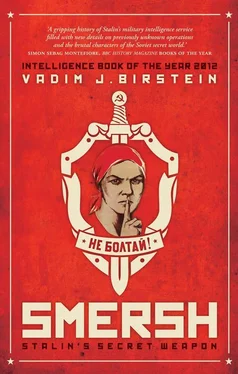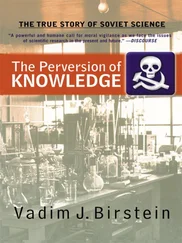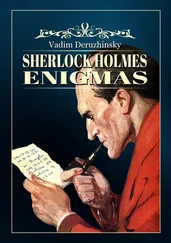Becoming head of SMERSH was a big promotion for Abakumov. As the chief of SMERSH’s predecessor, the UOO, he had been a subordinate of Lavrentii Beria, the notorious NKVD head. Now he was Beria’s equal, and his relationship with Stalin was a direct challenge to Beria.
Abakumov soon proved his worth, scoring impressive victories against the Germans. SMERSH had hundreds of double agents working among the Germans, especially in Abwehr intelligence schools. Many German agents therefore were known to SMERSH even before they crossed the front line, and were immediately identified and arrested. SMERSH also identified high-ranking intelligence and counterintelligence officers among German POWs and sent them to Moscow for interrogation. The level of intelligence about the enemy thus increased enormously. Deceptive ‘radio games’ or ‘playbacks’, in which captured German intelligence men and radio operators created fake German military broadcasts, were also a great success. However, the screening ( fil’tratsiya ) of Soviet servicemen who had been in German captivity, and the identification of spies, mostly imagined, among Soviet servicemen remained an important part of SMERSH’s job.
The Red Army’s advances into Eastern Europe meant that there were whole new classes of people to arrest: active members of political parties, local officials, diplomats, and so forth. Numerous Russian-émigré and White Guard organizations that had dispersed throughout Europe after the end of the Russian Civil War in 1922 were also a target. SMERSH arrested members of these organizations in Bulgaria, Romania, Czechoslovakia, Yugoslavia, and later in the Chinese provinces freed from Japanese occupation. But the group that SMERSH pursued most passionately was the Russian Liberation Army (ROA), which was formed from Soviet POWs in German captivity under the leadership of the former Soviet general Andrei Vlasov and his staff. Following the Yalta agreements with Stalin, British and American Allies forcibly handed over many units of the ROA and other anti-Soviet Russian troops, some of whom were even British citizens, to SMERSH. 51
People arrested by SMERSH were dealt with in a number of ways. Soviet servicemen were tried by military tribunals and then sent to punishment battalions or executed. Enemy agents of low importance were put in NKVD prisoner-of-war camps, while important prisoners were sent to SMERSH headquarters in Moscow, where they were intensively interrogated both during and after World War II. Among them were former leaders of European governments such as Count István Bethlen, the Hungarian prime minister from 1921 to 1930, and Ion Antonescu, the Romanian fascist dictator from 1941 to 1944, whose wife was also brought to Moscow. 52
Among SMERSH’s actions was the arrest of numerous diplomats. Some of them were guilty of crimes, like the Germans Gustav Richter and Adolf-Heinz Beckerle, both of whom played a crucial role in the Holocaust in Romania and Bulgaria. However, SMERSH also arrested completely innocent Swiss and Swedish diplomats, who were representing neutral governments. This was particularly galling to the Swedes, who had represented Soviet interests in Nazi Germany and Hungary for several years.
Perhaps SMERSH’s most infamous arrest was that of the Swedish diplomat Raoul Wallenberg, who saved many thousands of Jews in Budapest at the end of World War II by providing them with fake documents, establishing safe houses, pulling people off trains bound for extermination camps, and so forth. 53Named a Righteous Gentile by the Israeli government for his heroic actions, the truth of what happened to Wallenberg after his arrest by SMERSH is one of the deepest mysteries of World War II. It seems likely that he died in the Soviet investigation prison Lubyanka in 1947. 54An even deeper mystery is why he was never repatriated to Sweden, despite the fact that he was a member of the powerful Wallenberg family and worked for the family corporation. The Wallenbergs, whose wholly family-owned interests during World War II amounted to perhaps half the gross national product of Sweden, had also been involved in mutually beneficial financial dealings with the Soviet Union since the 1920s.
High-level Abwehr and SD (the foreign branch of the Nazi State Security) officers also became prisoners of SMERSH. Among them were Lieutenant General Hans Piekenbrock, head of Abwehr Abteilung (Department) I (foreign intelligence) from 1937 to 1943; Colonel Erwin Stolze, deputy head of Abwehr Department II (sabotage and subversion) from 1937 to 1944, who was known as Saboteur No. 2; and Lieutenant General Franz-Eccard von Bentivegni, head of Abwehr Department III (counterintelligence) from 1943 to 1944. 55
SMERSH also arrested and interrogated SS-Oberführer (Major General) Friedrich Panzinger, former head of the Gestapo’s Department A, which specialized in combating Communism and other opposition in Nazi Germany. He was well-known as the head of the Gestapo commissions that investigated both the famous Soviet spy network the Red Orchestra in 1942, and the anti-Hitler plotters in 1944. Between these two investigations, from September 1943 to May 1944, Panzinger headed the Gestapo branch in Riga, the capital of Latvia, and simultaneously commanded Einsatzgruppe A, a Latvia-based SS killing squad. After his release from Soviet imprisonment in October 1955, Major General Panzinger committed suicide while awaiting arrest in West Germany.
SS-Hauptsturmführer (Captain) Heinz Pannwitz, who headed the Gestapo’s investigation of the Red Orchestra in France, also fell into SMERSH’s hands. After his release, the CIA interrogated Pannwitz concerning his Red Orchestra investigation and his interrogations by SMERSH, and used the resulting information in its 1979 report, The Rote Kapelle . 56
Numerous high-ranking German military generals were also taken prisoner by SMERSH. 57Among them was the ruthless Lieutenant General Reiner Stahel, who was military commandant of Warsaw during the 1944 Uprising. He was arrested by SMERSH in Romania, where Hitler had sent him in a last-ditch effort to save the German troops stationed there. Stahel died in November 1955 in a transit POW camp, on his way to Germany as part of a large repatriation of German officers. Another SMERSH prisoner was SS Major General Wilhelm Mohnke. The Americans and Canadians mounted a ten-year search for him due to his order to kill Canadian POWs during the Normandy invasion in June 1944. It was only upon Mohnke’s release in 1956 that it became known that the Soviets had him all along. 58
SMERSH operatives also arrested a group of people who witnessed the death of Hitler. In fact, there were two groups of such witnesses in Soviet captivity, and there were two completely separate investigations into the circumstances of Hitler’s demise. These were conducted independently by SMERSH under Abakumov’s personal supervision and by the Main Directorate for POWs (GUPVI), which was part of the NKVD, under the supervision of the head of the GUPVI, Amayak Kobulov. 59The NKVD and SMERSH competed to find out the truth in order to curry favor with Stalin, who was fascinated with the Führer. Stalin suspected that Hitler had somehow survived the bunker, and therefore wanted convincing proof of his death. One of the witnesses investigated by SMERSH, SS-Gruppenführer (Lieutenant General) Hans Rattenhuber, head of Hitler’s bodyguards, was, possibly, the person closest to Hitler while he was alive.
Japanese military prisoners were investigated by SMERSH as well. They included General Otozo Yamada, commander in chief of the Kwantung Army, and the American-educated Senior Lieutenant Prince Fumitaka Konoe, who attended Princeton University before World War II. The young prince belonged to a 1,200-year-old family of Japanese rulers, and SMERSH considered him an important prisoner because he was a son and the personal secretary of Prince Fumimaro Konoe, the two-time former Japanese prime minister (1937–39 and 1940–41). In addition, Fumikata Konoe was related to Emperor Hirohito through his wife, Masako, a cousin of the emperor. Konoe, who had never been seriously ill, died suddenly in October 1956 in a transit POW camp on the way back to Japan. His death, like Raoul Wallenberg’s, remains a great mystery.
Читать дальше












